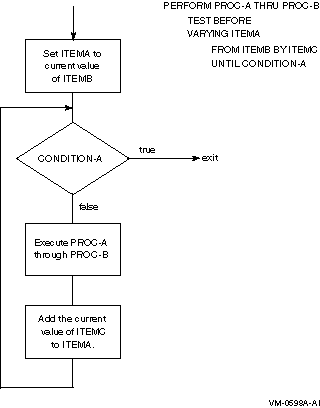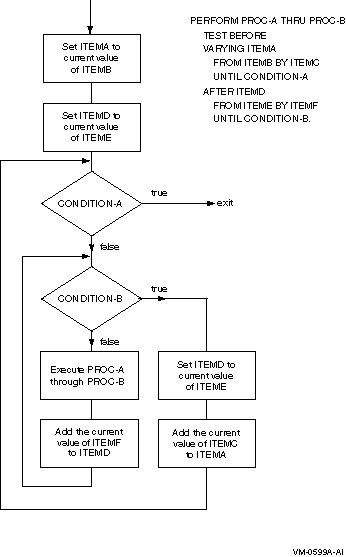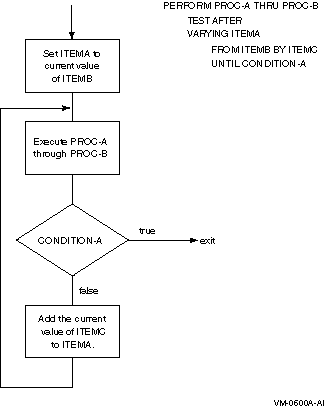 |
HP COBOL
Reference Manual
Format 1
- Format 1 is the basic PERFORM statement. The statement sets in the
PERFORM range execute once. Control then passes to the end of the
PERFORM statement.
Format 2
- The statement sets execute the number of times specified by
repeat-count. If the value of repeat-count is zero or
negative when the PERFORM statement executes, control passes to the end
of the PERFORM statement.
During PERFORM statement execution,
changing the value of repeat-count does not change the number
of times the statement sets execute.
Format 3
- The statement sets execute until cond is true. Control
then transfers to the end of the PERFORM statement.
- If cond is true when the PERFORM statement executes:
- If there is a TEST BEFORE phrase or one is implied, there is no
transfer to first-proc; control passes to the end of the
PERFORM statement.
- If there is a TEST AFTER phrase, the PERFORM statement tests
cond after the statement set executes.
Format 4
- The Format 4 PERFORM statement systematically changes the value of
var during its execution.
- If var is an index-name, its value, when the PERFORM
statement execution begins, must equal the occurrence number of an
element in its table.
- If init is an index-name, var must equal the
occurrence number of an element in the table associated with
init. As the value of the var index changes during
PERFORM execution, it cannot contain a value outside the range of its
table. However, when the PERFORM statement ends, the var index
can contain a value outside the range of the table by one increment or
decrement value.
- increm must not be zero.
- init must be positive when var is an index-name
and init is an identifier.
- If there is a TEST BEFORE phrase (or one is implied), and one
var is varied (see Figure 6-3):
- var is set to the value of init when the PERFORM
statement begins to execute.
- If cond is false, the statement set executes once. The
value of var changes by the increment or decrement value
(increm), and cond is evaluated again. This cycle
continues until cond is true. Control then transfers to the
end of the PERFORM statement.
- If cond is true when the PERFORM statement begins
executing, control transfers to the end of the PERFORM statement.
Figure 6-3 PERFORM ... VARYING with the TEST BEFORE Phrase and
One Condition

- If there is a TEST BEFORE phrase (or one is implied), and the
PERFORM statement has two vars (see Figure 6-4):
- The first and second vars are set to the value of the
first and second init when the PERFORM statement begins to
execute.
- If the first cond is true, control transfers to the end of
the PERFORM statement.
- If the second cond is false, the statement set executes
once. The second var changes by the value of increm,
and the second cond is evaluated again. This cycle continues
until the second cond is true.
- When the second cond is true, the value of the first
var changes by the value of the first increm, and
the second var is set to the value of the second
init. The first cond is reevaluated. The PERFORM
statement ends if the first cond is true. Otherwise, the cycle
continues until cond is true.
Figure 6-4 PERFORM ... VARYING with the TEST BEFORE Phrase and
Two Conditions

- At the end of a PERFORM statement with the TEST BEFORE phrase:
- The value of the first var exceeds the last-used value by
one increment or decrement value. However, if cond was true
when the PERFORM statement began, var contains the current
value of init.
- The value of each other var equals the current value of
its associated init.
- If there is a TEST AFTER phrase and one var is varied (see
Figure 6-5):
- var is set to the value of init when the PERFORM
statement starts to execute.
- The statement set executes once. Then, cond is evaluated.
If it is false, the value of var changes by the increment or
decrement value (increm), and the statement set executes
again. This cycle continues until cond is true. Control then
transfers to the end of the PERFORM statement.
Figure 6-5 PERFORM ... VARYING with the TEST AFTER Phrase and
One Condition

- If there is a TEST AFTER phrase, and two vars are varied
(see Figure 6-6):
- The first and second vars are set to the value of the
first and second init when the PERFORM statement starts to
execute.
- The statement set executes. The second cond is then
evaluated. If it is false, the second var changes by the value
of increm, and the statement set executes again. This cycle
continues until the second cond is true.
- When the second cond is true, the first cond is
evaluated. If it is false, the value of the first var changes
by the value of the first increm, the second var is
set to the value of the second init, and the statement set
executes again. The PERFORM statement ends if the first cond
is true. Otherwise, the cycle continues until cond is
true.
Figure 6-6 PERFORM ... VARYING with the TEST AFTER Phrase and
Two Conditions

- At the end of a PERFORM statement with the TEST AFTER phrase, the
value of each var is the same as at the end of the most recent
statement set execution.
- During execution of the sets of statements in the range, any change
to var, increm, or init affects PERFORM
statement operation.
- When there is more than one var, var in each
AFTER phrase goes through a complete cycle each time var in
the preceding AFTER (or VARYING) phrase is varied.
Additional References
Examples
In the examples' results, s represents a space. The examples assume
these Data Division and Procedure Division entries:
DATA DIVISION.
WORKING-STORAGE SECTION.
01 ITEMA VALUE "ABCDEFGHIJ".
03 CHARA OCCURS 10 TIMES PIC X.
01 ITEMB VALUE SPACES.
03 CHARB OCCURS 10 TIMES PIC X.
01 ITEMC PIC 99 VALUE 1.
01 ITEMD PIC 99 VALUE 7.
01 ITEME PIC 99 VALUE 4.
01 ITEMF VALUE SPACES.
03 ITEMG OCCURS 4 TIMES.
05 ITEMH OCCURS 5 TIMES.
07 ITEMI PIC 99.
PROCEDURE DIVISION.
.
.
.
PROC-A.
MOVE CHARA (ITEMC) TO CHARB (ITEMC).
PROC-B.
MOVE CHARA (ITEMC) TO CHARB (10).
PROC-C.
ADD 2 TO ITEMC.
PROC-D.
MULTIPLY ITEMC BY ITEMD
GIVING ITEMI (ITEMC, ITEMD).
|
- Performing one procedure (Format 1):
ITEMB = Asssssssss
- Performing a range of procedures (Format 1):
PERFORM PROC-A THRU PROC-B.
|
ITEMB = AssssssssA
- Performing a range of procedures (Format 2):
PERFORM PROC-A THRU PROC-C
3 TIMES.
|
ITEMB = AsCsEssssE
ITEMC = 07
- Performing a range of procedures (Format 4):
PERFORM PROC-A THRU PROC-B
VARYING ITEMC FROM 1 BY 1
UNTIL ITEMC > 5.
|
ITEMB = ABCDEssssE
ITEMC = 06
- Testing the UNTIL condition after execution (Format 4):
PERFORM PROC-A THRU PROC-B
TEST AFTER
VARYING ITEMC FROM 1 BY 1
UNTIL ITEMC > 5.
|
ITEMB = ABCDEFsssF
ITEMC = 06
- Performing a range of procedures varying a data item by a negative
amount (Format 4):
PERFORM PROC-A THRU PROC-B
VARYING ITEMC FROM ITEMD BY -1
UNTIL ITEMC < ITEME.
|
ITEMB = sssDEFGssD
ITEMC = 03
- In-line PERFORM (Format 4):
PERFORM
VARYING ITEMC FROM 1 BY 2
UNTIL ITEMC > 7
MOVE CHARA (ITEMC) TO CHARB (ITEMC)
MOVE CHARA (ITEMC) TO CHARB (ITEMC + 3)
END-PERFORM.
|
ITEMB = AsCAECGEsG
- Varying two data items (Format 4):
PERFORM PROC-D
VARYING ITEMC FROM 1 BY 1 UNTIL ITEMC > 4
AFTER ITEMD FROM 1 BY 1 UNTIL ITEMD > 5.
|
ITEMG (1) = 01s02s03s04s05s
ITEMG (2) = 02s04s06s08s10s
ITEMG (3) = 03s06s09s12s15s
ITEMG (4) = 04s08s12s16s20s
|



